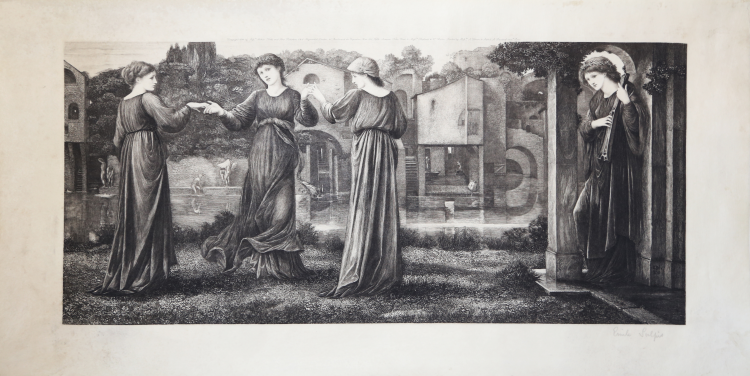



| Reference: | S39912 |
| Author | Émile Jean Sulpis |
| Year: | 1899 |
| Measures: | 620 x 315 mm |


| Reference: | S39912 |
| Author | Émile Jean Sulpis |
| Year: | 1899 |
| Measures: | 620 x 315 mm |
Etching, 1899, lettered along the upper margin “Copyright 1899 by Mess.rs Arthur Tooth and Sons…”.
After a painting by Sir Edward Burne-Jones (1833-1898), dated 1870, in in The Victoria & Albert Museum. London.
The Three Graces dancing while Apollo, who stands at right, plays; beyond, a canal, and on the opposite side, some figure wandering among buildings.
Burne-Jones was acquainted with the Ionides family by 1869 and the Mill was commissioned by Constantine Alexander Ionides. The three female models, also related to the family, were Aglaia Ionides, Marie Spartali, and Maria Zambaco
Arthur Tooth & Sons was a prominent art gallery located at no. 5 and 6 Haymarket in London, near the establishment of another picture dealer, McLean. The firm was founded in 1842 by Charles Tooth, a carver and framer, to set up his son, Arthur, in business. Until the 1880s, the gallery dealt in the occasional 18th-century, but mainly 19th-century British and some Continental paintings, thereafter expanding into old master paintings. Arthur Tooth also had a New York location from around 1900 until 1924 as well as a branch in Paris. The London branch remained in business until the 1970s. Like most of the other larger dealers, Tooth also published reproductive prints, the "cash cow" of the Victorian art market.
Émile Jean Sulpis (1856 – 1942)
|
Is today mostly remembered as an etcher-engraver. His father, Jean-Joseph Sulpis, was an architectural engraver, who likely taught his son most technical aspects of the trade, as used to be the tradition. Sulpis “son” received further formal trailing in the studios of Alexandre Cabanel and Louis-Pierre Henriquet Dupont. Today mostly forgotten, Sulpis started, like his father, etching for illustrations of books and other publications. He was exacting, and could render textures with very fine lines in a way that few could. He is known to have collaborated on a book devoted to Japanese jade with Henri Guérard. After 1900 Sulpis increasingly used his own imagination to create etched compositions in states which he liked to rework, and often hand colored. He mostly etched on a smaller scale. His compositions are charming and unusual in their frequent use of metallic inks.
Sulpis was well known in his time, having exhibited at the Paris “Salon des Artistes Français” from 1880 (awarded hors-concours in 1890). He was “Prix de Rome” in 1884; and received distinctions at the salons: commendation in 1890; silver medal in 1892; gold medal in 1894. He won the “Grand Prix” at the “Exposition Universelle” of 1900 and was awarded a medal of honor in 1905; was made “Chevalier de la Légion d'Honneur” in 1900; and finally became a member of the “Académie des Beaux-Arts” in 1911.
|
Émile Jean Sulpis (1856 – 1942)
|
Is today mostly remembered as an etcher-engraver. His father, Jean-Joseph Sulpis, was an architectural engraver, who likely taught his son most technical aspects of the trade, as used to be the tradition. Sulpis “son” received further formal trailing in the studios of Alexandre Cabanel and Louis-Pierre Henriquet Dupont. Today mostly forgotten, Sulpis started, like his father, etching for illustrations of books and other publications. He was exacting, and could render textures with very fine lines in a way that few could. He is known to have collaborated on a book devoted to Japanese jade with Henri Guérard. After 1900 Sulpis increasingly used his own imagination to create etched compositions in states which he liked to rework, and often hand colored. He mostly etched on a smaller scale. His compositions are charming and unusual in their frequent use of metallic inks.
Sulpis was well known in his time, having exhibited at the Paris “Salon des Artistes Français” from 1880 (awarded hors-concours in 1890). He was “Prix de Rome” in 1884; and received distinctions at the salons: commendation in 1890; silver medal in 1892; gold medal in 1894. He won the “Grand Prix” at the “Exposition Universelle” of 1900 and was awarded a medal of honor in 1905; was made “Chevalier de la Légion d'Honneur” in 1900; and finally became a member of the “Académie des Beaux-Arts” in 1911.
|